Advocate Michelle Poyourow of the Bicycle Transportation Alliance (BTA) was one of over 70 people that testified in front of City Council at last week’s public hearing on the Columbia River Crossing project (CRC).
After the hearing, several people mentioned her testimony to me and I also noticed it referenced in a recap of the hearing in the Daily Journal of Commerce*. In the interest of sharing the perspective of the BTA on this massive project (both in size and importance to our region), I asked if we could reprint her testimony.
(*The DJC incorrectly reported that the BTA testified in support of a 10-lane bridge (which, as you can see from the testimony below, they did not). Poyourow has asked them for a correction.)
As you read her words below, notice that she never even mentions bicycles:
“…we do not believe some of the key claims that are being made by CRC staff and the DOTs about the effects of this project on our region.”
My name is Michelle Poyourow. I am an advocate for the Bicycle Transportation Alliance and our 5,000 members in Oregon and SW Washington.
Our members want us to pay attention to the Columbia River Crossing project because as taxpayers they want it to be a good investment; as neighbors they fear its potential to degrade their communities; and as workers and business owners they need it to move people and freight reliably, for a long time to come.
The BTA has dedicated a staff person to track CRC planning and to sit on a project subcommittee for the last 1 1/2 years. But we do not believe some of the key claims that are being made by CRC staff and the DOTs about the effects of this project on our region.
We believe the Columbia River Crossing can be built in a way that improves our economy and environment. But to do so, it must be BOTH designed AND tolled in a way that inhibits the ‘induced demand’ which usually accompanies new highway capacity of this magnitude.
What is ‘induced demand’? It can be described as a supply of something (in this case, road capacity) actually leading to more demand (in this case, traffic). We can all see what happened to the Glenn Jackson Bridge, which added lots of capacity, lacked any tolls, and accordingly induced sprawling new development – and therefore far more traffic – than the planners forecast.
That is why you must take the CRC projections with an grain of salt: highway planners have been wrong in their projections before, many times over. The Glenn Jackson Bridge is but one example of a growing history of road-expansion projects that were projected to relieve congestion but, once built, only generated more. Transportation infrastructure is different from other forms of infrastructure because the supply and demand influence one another: if we build more schools, people do not have more children; if we build more sewers, people do not use the toilet more; but if we build bigger roads, people DO drive more.
“The bottom line is that a major capacity expansion is on the table; more lanes across the river will move more traffic across the river, no matter what you call them.”
There are three flaws in the project staff’s current conclusions: one, they claim that a 12-lane bridge will not induce much more traffic, but their analysis rests entirely on the assumption of tolls – yet no agreement has been reached on tolls.
Two, the use of the term “add/drop” and “auxiliary” lanes is misleading. One of them is nearly five miles long! Many of the trips taken over this bridge even today are less than 5 miles long, but those trips are not “auxiliary” – they are real, and they eat up real road capacity. The bottom line is that a major capacity expansion is on the table; more lanes across the river will move more traffic across the river, no matter what you call them.
Three, although CRC staff and the state highway departments will tell you the projections were compiled by Metro, what they will not tell you is that Metro was instructed to hold land uses constant in all of those projections. So the question this Council asked last spring – ‘Will the new highway capacity lead to changes in land use, and thereby induce development and demand?’ – becomes a tautology: the planners say the new capacity will not change land uses only because they were told to assume no changes in land uses.
For your action on February 25th, we respectfully suggest that you tie any decision on the number of lanes to an agreement on tolling to manage demand and to balance auto, freight and transit use over the I-5 and I-205 bridges. To do otherwise would mean a bridge of ANY width is likely to become as gridlocked as the current six lane bridge, due to the induced demand that CRC staff have not included in their projections. And that is an outcome that would be bad for everyone.
Thank you.
There seems to be a lot of momentum right now for a 12-lane bridge. Even Portland City Commissioner Randy Leonard is beating the drum for 12 lanes. His support led The Oregonian editorial board — who are also in favor of a 12-lane span — to publish a pieced titled, Leonard leads way on I-5 bridge.
But today, The Oregonian has published (on their online-only “The Stump” section) a guest opinion piece by Metro Council president David Bragdon. In it, he writes:
“We want this project built, and we want it built in a manner that serves its purpose rather than defeats its purpose…
Again, my conclusion is that there is far more upside potential in this project than downside risk. But with all due respect, the boosters (and now your editorials and columns) have downplayed the risks of a “too big” bridge and their possible costs.”
— Browse our previous coverage of the Columbia River Crossing project. Also, read how the BTA’s stance on the CRC has evolved over time:


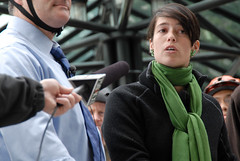
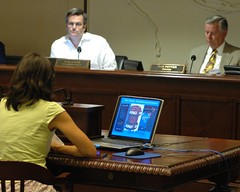
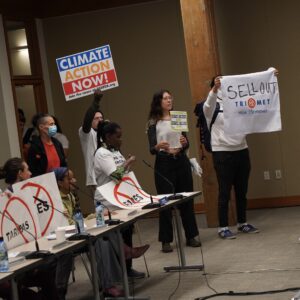
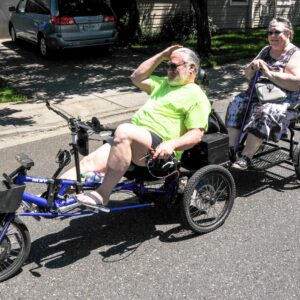

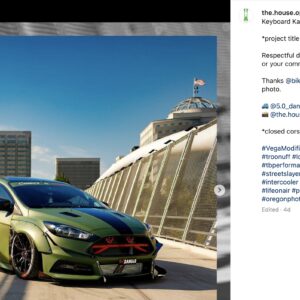
Thanks for reading.
BikePortland has served this community with independent community journalism since 2005. We rely on subscriptions from readers like you to survive. Your financial support is vital in keeping this valuable resource alive and well.
Please subscribe today to strengthen and expand our work.
Wow… very informative testimony by Michelle and the BTA. Thanks for publishing and thanks to BTA for making our voice heard!
Thanks for publishing this Jonathan.
There’s a pretty serious nexus between the size, and affordability, of the bridge and the quality of the bike facility that will go with it.
But we also have heard from BTA members that they have grave concerns that go far beyond the quality of the bike facility – concerns about their neighborhoods, their bikes routes, the air they breathe and the way their scarce transportation dollars are spent.
I should point out that the DJC incorrectly reported that we testified in support of a 10-lane bridge (which, as you can see from my testimony, we did not). I’ve asked them for a correction but have not received a response.
Great to see Michelle and the BTA educating the City Council, which appears to be totally ignoring the induced demand effect and concomitant increases in carbon and hazardous air pollutant emissions, not to mention impacts on Portland’s livability. Thank you!
I have yet to hear where the money for this is coming from.
I have yet to hear why the existing bridges MUST be torn down and replaced.
Both states are looking for ways to cut their budgets and Washington has already committed itself to spending billions replacing the Alaska Way viaduct in Seattle.
But the biggest question I have is why? The current bridges are structurally sound. They could be upgraded to current seismic standards for well under a billion. The ramps can be redone without a new bridge. Yet in so many articles I’ve read that the existing bridges must be replaced, but they never say why.
Wait, did Bragdon steal her quote about schools and sewers?
To the mattresses! Great job, Michelle. I’m proud to see the BTA speaking up for better planning and learning from the past. We mustn’t let wind turbines, trains, and “world class bike facilities” mask the bloated, untolled, embarrassment this project is becoming. After all the proud talk about how defeating the Mt. Hood freeway set Portland’s trajectory for being a center of sustainable transportation, I hope we can recognize the CRC as a similar opportunity.
My vote is to leave the bridge as is, add tolls even, and build a second bridge for MAX, bikes, and pedestrians.
Vancouver has sprawled in poorly planned, car-centeric developments. Portland has become more dense and has expanded mass transit and bike infrastructure.
I do not see much value in making it slightly easier for more cars from Vancouver to drive to Portland.
excellent testimony, Michelle! Seems like the BTA’s CRC position has evolved in a very intelligent way. Which is a relief to me.
Well said, Michelle! Your testimony was a high point.
With the number of interchanges in this project area, and with the proposed lengths of these “auxiliary” lanes, it starts to seem like what are essentially local roads are being grafted onto what is being presented as a project to preserve a vital interstate transport and shipping corridor.
We need to demand that City Council require an INDEPENDENT review of the project and its underlying assumptions.
A Transportation Demand Management consultant that (unlike the current CRC consultants) doesn’t have a vested interest in the project should be paid to really dig into the numbers/assumptions.
Look at how much they’re talking about spending:
$4,200,000,000/2,159,720 people in Portland = $1,945 per man, woman and child!
That’s an awful lot of money.
I’m with Erik. Toll the existing bridge, and dedicate the revenue to building a new, light rail, pedestrian, bike and local traffic bridge.
But if we can’t get the politicos behind that approach, we should demand an INDEPENDENT review of the project’s assumptions.
This is exactly why Michelle Poyourow is a rockstar! Awesome job!
I’d like to see the council also make approval contingent on federal funding, with a fallback plan if federal funding doesn’t materialize. Also, budgeting and construction should not even be decided on until the highway legislation is debated and passed later this year (which will frame the funding environment). This project has the potential to suck up all the available highway funds in order to ensure its completion – a half bridge doesn’t do anyone any good.
That was one of the more intelligent things I have read in a while.
Tolls seem to be a very direct way of not only limiting induced demand, tolls also directly reduce subsidies on auto & truck traffic. However the howling about tolls being a regressive tax will be difficult to endure.
With the economy in a tail spin it’s time to do the least cost option, first. That is tolling and congestion tolling. If it will work to reduce use on a new bridge it should work fine with the current bridge. The current bridge was built with tolling. This generation of people now feel entitled to consume every last dollar and borrow every last dollar that exist & it should be used for their “needs”. yet have someone else be responsible to pay it off. I’m worried about my retirement and trying to ask the young generation to help me after I’ve saddled them with all this debt.
Has any one considered a NO BRIDGE Option (not to be confused with a no build option)? Or more realistically leaving the bridge open only for neccesary interstate shiping? As a Vancouver resident, such an options seems absurd at first, but considering a No Bridge option would force Vancouver developers to stop catering to urban sprawl that serves as Portland’s overflow area; a No Brdige option might actually result in an improved development of Vancouver neighborhoods.
Can we think outside the predicatable?
GLV, I actually stole that “schools and sewers” analogy from David Bragdon – he deserves the credit for it.
It’s true, she stole it from me, but I stole it from Walter Kulash, a traffic engineer in Florida. I would never steal anything from Michelle K. Poyourow. I only steal from people who are at least three states away.
Keep these voices of sanity in the debate! I still wish the BTA would come out for a no build option and simply toll the current bridge, maybe upgrade for light rail but… keep at it Michelle. Great coverage, J.
Glad to see the BTA grow smarter and more articulate on this issue. Michelle — you rock! And so do you, David. 🙂
Let’s just hope people are listening, and not just beating the “we need a bridge” drum.
it seems Ms. Poyourow is not the rock star she would have us think. Check the Oregonian Stump of 2/3/09 for Bragdon’s piece about the bridge. Same argument, same language, same quotes, and not just one quote, but several. Tautology indeed.
Some rock stars sing duets.
Oh, I am so loving this.
We should get dedicated tram and bike lanes set aside on this bridge for future improvements. Cars should be tolled while cyclists get through for free.
That’s the spirit!